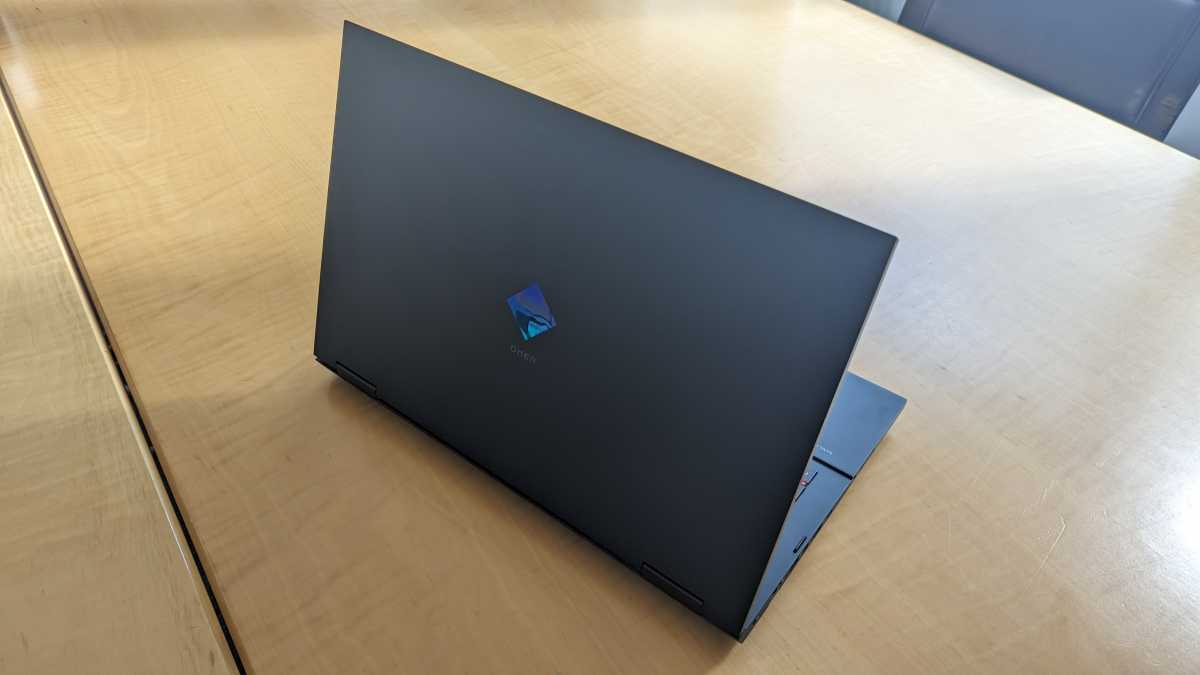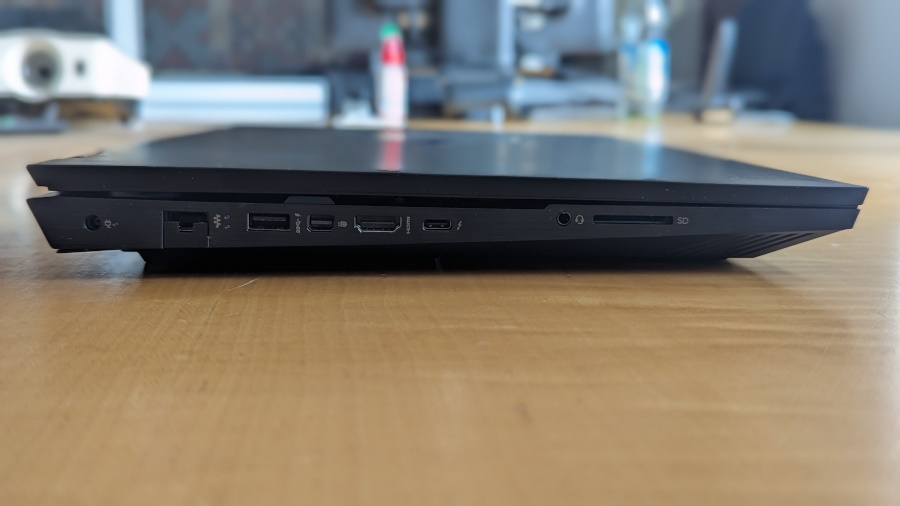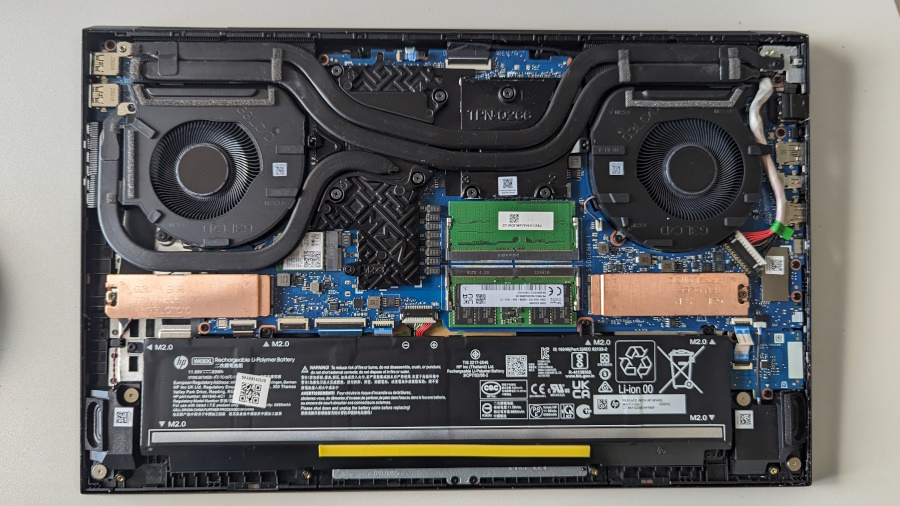Expert's Rating
Pros
- Top gaming performance
- Strong system performance
- Many connections
- Keyboard with numerous special keys
- Still relatively quiet
Cons
- Gets very hot on the underside
- Heavy
- 720p camera
- Weak battery life
- No 2.5 Gbit LAN
Our Verdict
The HP Omen 17 is a powerful package for gamers who crave speed and graphics firepower.
HP’s Omen line of laptops are known for their sheer speed and graphics firepower. The latest Omen 17 is no different in that regard, as it comes with a powerful Nvidia GeForce RTX 4080 GPU and an Intel Core i9-13900HX CPU. The refreshed core components from the new GPU (Ada Lovelace) and CPU generation (Raptor Lake) are the main differences to last year’s Omen 17. The casing remains largely unchanged, however. It also sits in a black chassis with a plastic underside and a lid adorned with the Omen logo and lettering. The angular design gives the impression of pure power.
While this laptop has a lot to offer, there are a few unimpressive aspects to it. Fingerprints on the lid and wrist rest are a nuisance after a short time. The lid also wobbles when you change the viewing angle and the case has no ports on the back, making cable management difficult. That said, those are minor quibbles with an otherwise outstanding gaming laptop.
Looking for more options? Check out PCWorld’s roundup of the best gaming laptops.
HP Omen 17: The Omen Hub
The Omen Hub is HP’s central configuration tool for gaming settings. You can organize your games there, create a gallery with wallpapers and screenshots, but above all use the dashboard to get a quick overview of the system load and tune the CPU and GPU. For benchmarking, we use the performance mode for the system and the “dedicated GPU” setting in the options for Advanced Optimus.

Thomas Rau
The GeForce RTX 4080, Nvidia’s second-best mobile GPU from the Ada-Lovelace generation, ensures speed in the HP Omen 17. It works with 7424 CUDA cores and 12 GB GDDR6 graphics memory and can consume up to 175 watts with the help of Dynamic Boost, the turbo clock is 2010 MHz. Like an RTX 4090, it’s integrated into the system with 16 PCIe 4 lanes while the other Ada-Lovelace GPUs can only utilize the bandwidth of PCIe 4 with 8 lanes.
It’s supported by the Intel Core i9-13900HX CPU. Like most manufacturers of high-end gaming laptops, HP relies on this processor with 24 cores and 32 threads, which are divided into 8 performance cores and 16 efficiency cores. Its intended power consumption in the Omen 17 is 130 watts, rising to 140 watts under load in the test.
HP Omen 17: Gaming performance
When it comes to speed, the Omen 17 is impressive in all respects. As for gaming performance, it’s only beaten by significantly more expensive notebooks with an RTX 4090, while laptops with a Ryzen 9 7945HX perform better as far as system performance goes.
In the 3D Mark Time Spy, the HP Omen 17 is around 15 percent behind laptops with the RTX 4090, but almost 50 percent ahead of models with the RTX 4070. The HP notebook is also just behind the RTX 4090 group in other tests such as Speedway or the Port Royal ray tracing test, but very clearly ahead of the RTX 4070 models.
Accordingly, most games do not cause the Omen 17 any problems in its native display resolution of 2560 x 1440. In Shadow of the Tomb Raider, for example, the bandwidth ranges from 169 fps in the “High” setting to 105 fps if you set all controls, including ray tracing, to ultra-high details. Dirt 5 also remains playable at 71 fps with ultra-high details and ray tracing shadows. Notebooks with an RTX 4090 deliver around 20 to 30 fps more in these games and around 15 fps with ray tracing. But even here, the gap between the RTX 4080 and the mid-range RTX 4070 is considerable and is up to 50 to 60 fps. However, if you can do without the high resolution, you can get the same performance much cheaper.

Thomas Rau
The current performance reference for gaming is Cyberpunk 2077: With the Omen HP 17, the game remains playable at 68 fps up to the “Raytracing Low” setting. Higher graphics quality causes the frame rate to drop below 60 fps, with only 21 fps remaining in ray tracing overdrive. An RTX 4090 only manages a few frames more, meaning that higher settings are not playable even with the top GPU model. By way of comparison: With an RTX 4070 and 1440p, Cyberpunk 2077 is only good enough for medium graphics quality if you want to stay safely above 60 fps. The combination of RTX 4070 and FHD, on the other hand, delivers similar results to the Omen 17.
However, if you activate DLSS 3 with Frame Generation, you no longer have to worry about the graphics settings in Cyberpunk 2077: AI scaling accelerates the Omen 17 to 82 fps even with Raytracing Overdrive.
HP Omen 17: Operating noise
The CPU benchmark Cinebench R23 not only determines the processor performance of a notebook, but also clearly shows how well the notebook manufacturer has cooling and fan noise under control.
The HP Omen 17 achieves over 25,000 points in this test, slightly lower than other gaming laptops with the Core i9-13900HX. This is because HP allows the CPU a slightly lower power consumption of 140 watts at its peak and around 100 watts on average, while the processor in other high-end laptops is allowed up to 160 watts maximum and 115 watts on average and can therefore achieve a higher clock rate.
Above all, HP wants to keep the fan noise to a minimum. In the endurance test, the laptop runs significantly quieter than similarly equipped notebooks at 53 dB(A), whereby “quieter” in the context of gaming notebooks is to be understood as “not quite as loud.” You should also definitely not use the Omen 17 within earshot of sensitive friends or colleagues for gaming.
Now onto the downside. The underside of the notebook gets very hot, we measured over 60 degrees at the hot spots. However, as long as you don’t place the laptop on a heat-sensitive surface or your thighs when gaming, you can ignore this test value. The temperature of the Omen 17 remains uncritical on the palm rest or the keyboard.

Thomas Rau
HP Omen 17: Top speed for multimedia
The HP Omen 17 is also among the top performers in the system performance test and delivers top values in all applications. In PC Mark 10, it is only slightly slower than gaming notebooks with a Ryzen 9 7945HX, which performs better, especially in programs that require many CPU cores.
Compared to gaming laptops with a Core i7 and RTX 4060, the Omen 17 is particularly impressive in multimedia tests. While it’s around 10 percent faster in office tasks, it’s almost 30 percent faster in photo and video editing.
The Omen 17 uses the NVMe SSD Kioxia XG8 as a drive. It offers the expected high data rates of around 7 and 5 GB/s for sequential reading and writing, but is clearly behind a Samsung PM9A1 in practical tests, which can be found in other high-end notebooks.

Thomas Rau
HP Omen 17: Loads of ports, mediocre camera
The Omen 17 is equipped to a high standard with 32GB RAM and 1TB SSD. The notebook offers three ports for external monitors, Thunderbolt 4 in addition to HDMI and Mini DisplayPort. You can also achieve data rates of over 20 Gbit/s with a suitable external hard drive via the flexible Type-C interface, while the three Type-A ports on the Omen 17 only allow a maximum of 5 Gbit/s (USB 3.2 Gen 1). The HP notebook also offers an SD card reader for memory cards.
However, the equipment list does not make us completely happy: The Omen lacks a 2.5 Gbit LAN port, for example – its network connection works at Gigabit speed – as well as a camera with Full HD resolution.
The SSD and RAM can be replaced in the Omen 17. There is a second M.2 slot for an additional drive.
HP Omen 17: High quality display
The 17.3-inch screen with a 16:9 aspect ratio shows 2560 x 1440 pixels. This means that the display is not as detailed as a 16-inch laptop with a slightly higher WQXGA resolution, for example. The 165Hz refresh rate of the Omen 17 is also not to be scoffed at, but in view of 300Hz displays, it’s not the measure of all things.
The picture quality is very decent. The test results show good values for brightness at just under 350 cd/sqm, contrast at 960:1, and color reproduction with 99% sRGB coverage. However, the Omen 17 cannot keep up with very good LED displays, mini-LED screens, or OLEDs.
HP Omen 17: The keyboard is a little different
As usual with Omen devices, this one has a key layout that deviates from the standard. Instead of a numeric keypad, there are nine shortcut keys on the right and a further six on the left. The four arrow keys, which are easily accessible at the bottom right of the test field, have a standard size. However, the Enter key is only single-line.
Typing on the keyboard with optical-mechanical switches is quiet, only the space bar bounces more audibly. However, the pressure feedback of the individual keys could be a little more pronounced.
The touchpad, on the other hand, confirms a mouse click clearly and loudly. If you play with the built-in mouse instead of an external mouse, you will be pleased with the fast and precise mouse movements. The touchpad also quickly implements multi-finger gestures.
In the Omen Gaming Hub, lighting effects can be set for four keyboard zones. For additional RGB effects, the Omen Light Studio program must be downloaded.
HP Omen 17: Battery life
The Omen 17 is clearly a desktop laptop. Weighing over six pounds, it can only be used on the move within your own four walls, especially as the power supply weighs just under another 2.8 pounds and the battery life is under three hours.
HP Omen 17: Benchmarks and specifications
| HP Omen 17-ck2097ng: Test results | |
| System performance | |
| Speed in office programmes | 96 points (out of 100) |
| Speed in multimedia programmes | 100 points (out of 100) |
| 3D performance | |
| 3D Mark performance | 88 points (out of 100) |
| Gaming score | 85 points (out of 100) |
| Display | |
| Brightness / brightness distribution / contrast | 348 cd/m² / 84 % / 960:1 |
| Anti-glare display | yes |
| Colour gamut coverage (in percent) | sRGB: 99 / Adobe-RGB: 76 / DCI-P3: 76 |
| Colour fidelity (Delta-E deviation) | 1,72 |
| Battery life | |
| Battery life (hours:minutes): WLAN test | 02:49 |
| Ergonomics | |
| maximum operating noise under load | 53 dB(A) |
| Temperature top / bottom | 39 / 62° Celsius |
| HP Omen 17-ck2097ng: Equipment | |
| Processor | Intel Core i9-13900HX |
| Clock rate | Standard clock: 2.4 GHz (P-Cores), 1.6 GHz (E-Cores); Turbo clock up to 5.4 GHz (P-Cores), 3.9 GHz (E-Cores) |
| Cores / Threads | 24 / 32 |
| RAM | 32 GB DDR5-5600 (removable) |
| Graphics card | Nvidia Geforce RTX 4080 |
| Graphics memory | 12 GB GDDR6 |
| GPU: Clock rate / TGP | 990 MHz (Standard), 2010 MHz (Boost) / 175 Watt |
| Drive | NVMe SSD Kioxia XG8 (PCIe 4.0 x 4) |
| usable capacity | 952.96 GB |
| Format | M.2 2280 |
| Network: LAN / WLAN / Bluetooth | Gigabit / WiFi-6E (Intel AX211) / 5.3 |
| Operating system | Windows 11 Home |
| Display: Diagonal / resolution / format | 17.3 inch / 2560 x 1440 / 16:9 |
| Dot density / refresh rate | 170 ppi / 165 Hz |
| Weight: Notebook (with battery) / power supply unit | 2774 / 1260 grams |
| Battery: Capacity | 83 Wh |
| Connections on the left | 1x HDMI 2.1, 1x Mini-Displayport, 1x Type-A (USB 3.2 Gen 1), 1x Type-C (Thunderbolt 4 with USB 4 40 Gbit/s, Displayport output, Power Delivery), 1x memory card reader (SD card), 1x LAN, 1x audio, 1x power |
| Connections on the right | 2x Type-A (USB 3.2 Gen 1) |
| Further features | Front camera (720p) |
This review was translated from German to English and originally appeared on pcwelt.de.
